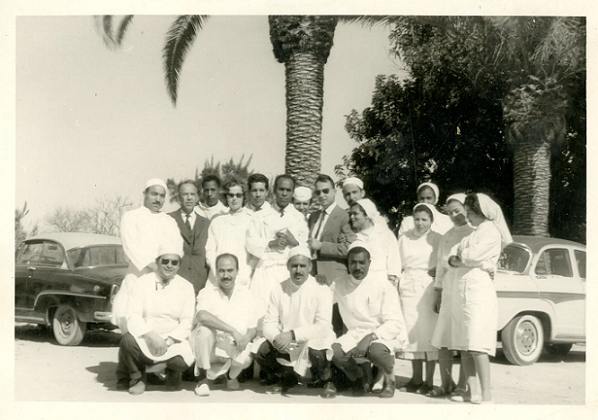
Jennifer Szalai (The New York Times) writes, “Adam Shatz’s The Rebel’s Clinic, a new biography of the psychiatrist and revolutionary Frantz Fanon, aims to restore complexity to a man both revered and reviled for his militancy.” Here are excerpts from “When Violence Was What the Doctor Ordered.”
Rhetoric that is polemical, that is caustic, that is ruthlessly extreme is potent in one sense yet vulnerable in another. It seizes attention and attracts acolytes; it is memorable and therefore memeable. But such strength can also be brittle. Writers who deploy it are susceptible to being cherry-picked and caricatured. They get enlisted in disparate causes and excerpted in college syllabuses. They become icons — whether to be smashed or revered.
I kept thinking about this paradox while reading “The Rebel’s Clinic,” Adam Shatz’s absorbing new biography of the Black psychiatrist, writer and revolutionary Frantz Fanon. In the decades since his death in 1961, Fanon has become that figure of double-edged distinction: an “intellectual celebrity,” as Shatz puts it, whose writing has been recruited for “a range of often wildly contradictory agendas” — secular and Islamist, Black nationalist and cosmopolitan — each trying to claim his uncompromising energy for its own.
For all his unwavering radicalism, he led a roving existence. He was born on the French Caribbean island of Martinique in 1925 and died, at 36, in a hospital in Bethesda, Md., in what he had called “the country of lynchers.” In between, he fought the Nazis in France, directed a psychiatric hospital in Algeria and eventually became a spokesman for that country’s National Liberation Front, known as the F.L.N., in its war against French colonial rule.
He was both a militant and a doctor, someone who promoted a “belief in violence” while also practicing a “commitment to healing.” An acquaintance recalls being struck by Fanon’s compassion: “He treated the torturers by day and the tortured at night.”
Fanon’s French secretary told Shatz that she hated seeing Fanon “chopped into little pieces,” arguing that those who tried to isolate one part of the man and his work “missed the indissoluble whole.” Shatz’s book is an attempt to restore a sense of fullness to Fanon, whom he largely, though not unconditionally, admires.
Fanon could be “vain, arrogant, even hotheaded.” In his first book, “Black Skin, White Masks” (1952), he derided homosexuality and wondered about “women who just ask to be raped.” During the last months of his life, while dying of leukemia, he wrote “The Wretched of the Earth” (1961). It depicted violence committed by colonial subjects against their oppressors as not only a matter of strategy, but also a psychological boon.
“Violence is a cleansing force,” Fanon wrote. (Shatz says that the line is better translated as “violence is dis-intoxicating.”) “It rids the colonized of his inferiority complex, of his passive and despairing attitude.” This was the kind of incendiary declaration that made some readers, including those who were politically sympathetic, recoil. The left-wing journalist Jean Daniel wrote a positive review in L’Express while confiding his revulsion to his diary: “a terrible book, terribly revealing, a terrible harbinger of barbaric justice.”
Shatz, the United States editor for The London Review of Books, is a mostly steady hand in turbulent waters. His chosen title highlights a side of Fanon that often gets eclipsed by the larger-than-life image of the zealous partisan — that of the caring doctor, one who was a “painstaking, diligent reformer in his day-to-day practice as the director of a mental hospital,” and, eventually, of a secret clinic for Algerian rebels. (David Macey’s 2001 biography offers more detail on Fanon’s upbringing in Martinique.) [. . .]
Because, of course, violence is a core part of “The Wretched of the Earth,” something that Shatz addresses head on, offering a smart, careful reading. He blames Jean-Paul Sartre’s notorious preface (“Violence, like Achilles’ spear, can heal the wounds it has inflicted”) for fixating on the book’s first chapter, “On Violence” — glorifying carnage without heeding Fanon’s call to channel such impulses “into a disciplined armed struggle.” Shatz directs our attention to Fanon’s last chapter, which includes wrenching case studies from his practice, involving both victims and perpetrators of violence. These show that even as Fanon wrote messianically about anticolonial violence, “he did not expect the psychological damage to be easily repaired.” [. . .]
For full review, see https://www.nytimes.com/2024/01/21/books/review/the-rebels-clinic-adam-shatz-frantz-fanon.html
[Photo above: Frantz Fanon, in the center of the second row, at his psychiatry clinic in Tunis, circa 1959. Credit: Archives Frantz Fanon/Imec.]
Jennifer Szalai (The New York Times) writes, “Adam Shatz’s The Rebel’s Clinic, a new biography of the psychiatrist and revolutionary Frantz Fanon, aims to restore complexity to a man both revered and reviled for his militancy.” Here are excerpts from “When Violence Was What the Doctor Ordered.” Rhetoric that is polemical, that is caustic, that





